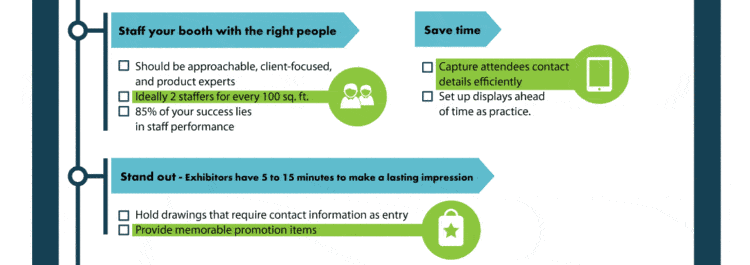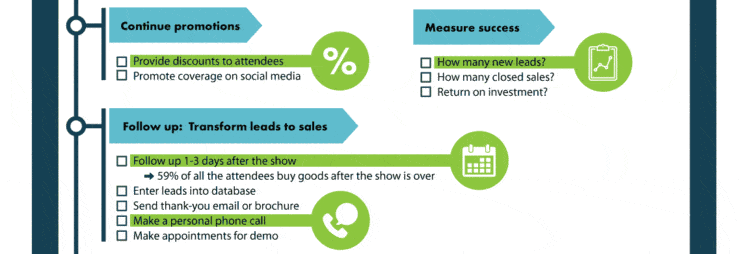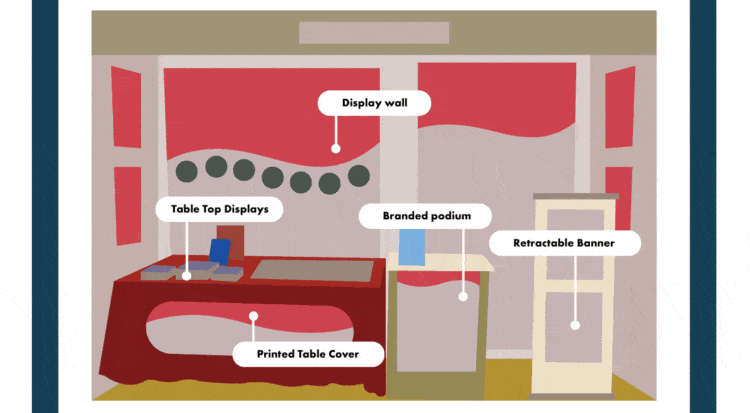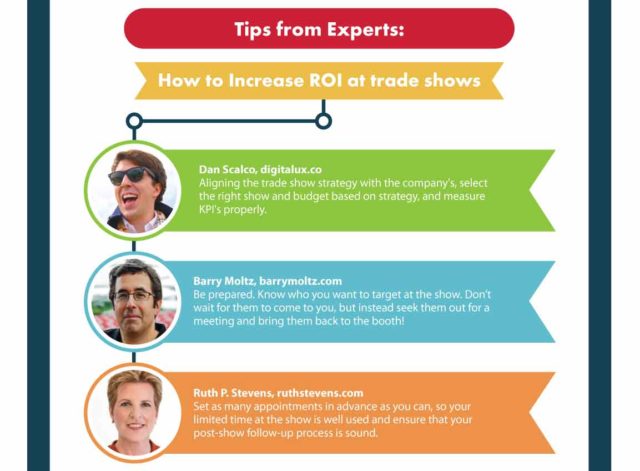Steps to a Successful Trade Show
Trade shows can be costly, it’s true. With the expenses you’ll incur in the preparation of the booth, training of staff members, and cost to get to the location, the amount can pile up. However, with proper strategizing and implementation, you can get the most out of a trade show. For example you will be able to attract new clients and reach out to existing customers. Basically, a trade show gives you a chance to get your name and your business out there.
The steps below can help you achieve trade show success and keep yourself organized until after the event has ended.
Before the Trade Show

-
Choose the show most in line with your business goals.
There are plenty of trade shows, yet not all of them cater to a specific line of business. Before deciding on THE ONE, do your research. Has this trade show been held annually for several years already, and if so, how did the previous shows do? Are the trade show’s goals in line with my own? Is the location good for both my business products and my prospective clients?
-
Set clear and measurable goals and objectives.
Before the event, draw up clear goals. Determine the reasons why you decided to participate in this certain trade show. What do you hope to achieve? Is it just to make connections? Or are you interested in figuring out the current trends in the industry so you could build upon these trends? Do you hope to gain insights about strategies for improving the marketing of your business? Make sure these goals and objectives are measurable. That way, you can evaluate if they were met and to what extent after the show.

-
Put up an effective exhibit.
Once you’ve secured your spot in the trade show, come up with a creative exhibit that will not only showcase your business effectively, but will also draw in even the most uninterested of the attendees. Utilize space well, and make use of colorful signs and banners in order to grab the attendees’ attention.
-
Prepare everything you need.
As with any important event, preparation is very important in trade shows. Make sure you have all that you’ll need, and anything you think you might need at any time during the event. These can be adaptors, extra power strips, pens and paper, as well as hygiene items. If you can, make a separate checklist for the things you’ll need to bring on the day of the trade show.

-
Promote the event.
If possible, obtain a copy of the list of registered attendees. This way, you can send them invites to your booth early on. You could also set up pre-trade show events intended to build up the hype and anticipation for your booth at the trade show.
During the Trade Show

-
Man your booth with the right staff.
You can be very diligent about the preparations for the trade show, but it won’t work unless you have knowledgeable people manning your booth. It’s very important to have polite, well-trained, and engaging individuals to manage your spot and effectively discuss about your product or your business. This can be the key to luring in prospective clients. Ideally, you should have 2 staff members for every 100 square feet of space in your booth.
-
Work efficiently.
In order to get as much potential business out of the trade show, you must be efficient. Use lead management software to help you in sorting prospects, and plan the layout of your booth in such a way as to maximize productivity, taking into account the huge number of attendees passing your way throughout the event.
-
Stand out from the crowd.
Trade shows usually bring together like-minded individuals and business owners, so don’t be surprised to see your competitor setting up a booth not far from your own. This is why it is important to create an effective strategy that will let you stand out from the crowd and make a lasting impression on your prospects within 5 to 15 minutes.
After the Trade Show

-
Keep up with promotions.
The trade show is not the end point. Rather, it should be taken as a jump-off point that can open up new directions to your business. After the show, be sure to keep up with the promotions in order to keep the fire ignited at the event burning. SNS can work to your advantage by spreading word of your business to anyone with access to the internet. And so will providing discounts to those who attended the trade show, as they will be more likely to try out your products and services and share their experiences.
-
Evaluate your success.
Time to bring out the goals and objectives you set prior to the event. If you were able to set your goals up to be measurable, this is the time evaluate the results that you got out of the trade show, and compare them with your pre-determined goals. This can help you figure out the next best step to promoting and improving your business.
-
Follow up on leads.
If you were able to get a lot of leads from the trade show, it shouldn’t stop there. Convert those leads to sales by sending thank you cards or follow up notes, or you can even have your staff call each prospect over the phone to thank them personally for their time and interest. Studies have shown that personalization can actually lead to an increased possibility of an appointment after the show.
Key Components of a Trade Show Booth

The layout for your trade show booth should be carefully planned out. You want it not only to showcase your products effectively, but also to grab people’s interests. Table top displays, table covers, retractable banners, podiums, and a well done display wall are key elements to an effective trade show booth.
Helpful Tips from the Experts
Trade show activities can be costly, but with careful planning and meticulous preparation, you can definitely get your money’s worth from them. Read what our experts have to say about maximizing the results of your trade show activities, and increasing your return of investments.


Comments are closed.